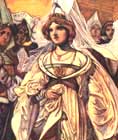
Cinderella:
345 Variants
by Marian
Roalfe Cox
SurLaLune's
Cinderella Area
SurLaLune Fairy Tales Main Page
288
Household Stories from the Land of Hofer; or, Popular Myths of Tirol. By the author of "Patranas, or Spanish Stories," etc. [Miss R. H. Busk.] London, 1871. P. 158. (Translation or adaptation from some undisclosed source. The scene of the tale is laid in the Passeier Thal.)
"KLEIN-ELSE."
ABSTRACT
Father, defeated in battle and mortally wounded, directs heroine to escape--Heroine disguise (rags)--Heroine flight-- Knight-aid--He bids rock open disclosing treasure, which heroine may use--He will return in seven years, and she must by no means have forgotten his name--Menial heroine (poultry-maid at nobleman's castle)--Magic dresses (from rock)--Meeting place (church)--Threefold flight--Money scattered to hinder pursuit--Lovesick baron, will eat nothing but pancakes--Cook's pancakes are burned; heroine's are used--Recognition food (contains ring slipt on heroine's finger at church, and diamond ring taken from rock)--Heroine appears before baron in state after visiting rock--Happy marriage--The seven years pass, mysterious knight returns. Heroine has forgotten hi name. He takes her to rock, which opens and, in place of treasure, discloses all the misery she might have relieved. Husband finds dead body of heroine kneeling beside treasure-rock.
TABULATION
(1) A nobleman, defeated in battle by his enemy, and mortally wounded, gives directions to his only daughter how to escape.-- (2) She flies, disguised in rags, and (3) meets an unknown knight at the foot of a certain rock. He takes pity on her, and saying, "Open, hoary rock!"1 displays a hidden treasure, from which he gives her leave to come and take whatever she will, but she is to make good use of it, for on that will depend her future happiness. He will return in seven years to see what use she has made of it, and meantime she is to remember his name, or woe will betide her. She takes a few pieces of money, and, going on her way, takes service (4) as a poultry-maid at a young nobleman's castle.-- (5) On Sunday she goes to the rock, and, taking a robe of sunbeams, goes to church, where she is seen by the young baron. Afterwards she returns the dress, and resumes her rags.-- (6) The next Sunday she takes from the treasure a robe of moonbeams. The baron orders his waiting-men to detain her as she leaves the church, but she escapes them by scattering money.-- (7) The third Sunday she chooses a garment blue like the sky, and sparkling with stars. The baron slips a gold ring on her finger before she leaves the church, and again she contrives to escape his waiting-men as before.-- (8) He falls ill with love, and refuses every amusement. His aunt, the Countess Janfenstein, proposes a banquet to which everyone from far and near is to be invited. He agrees to this, but will eat nothing b pancakes. The cook, in her anxiety, burns them.-- (9) Klein-Else, the poultry-maid, tries her hand, makes a pancake, and puts the ring he has given her into it, and also a diamond-ring taken from the rock. The baron finds them, and sends for the cook, who is compelled to confess who made the pancake.-- (10) Meantime, Klein-Else goes to the rock and obtains a splendid dress and a retinue of servants. The baron sends for her; she comes in state, and declares her true name and rank. They are married, and have several children.-- (11) The seven years pass, and the mysterious knight comes to find her. She has forgotten his name. He takes her to the treasure-rock and bids it open. She sees within, instead of treasure, all the misery she might have relieved, but has omitted to relieve in her selfish enjoyment of the good fortune which has come to her. Her husband, seeking her, finds only her dead body kneeling against the treasure-rock.
NOTES
Note 38
(P. 250.) Treasure-rocks open in Nos. 97, 102, 103, 105, 106, 107, 108, 194, 252, 253, 304 (stone-cross opens); usually when struck with a rod. (In No. 257 the heroine keeps her dresses in a rock cavern.) Compare the rock-opening in Hiawatha, also in the following: Bleek, Hottentot Fables, p. 64; Callaway, p. 140, "The Rock of Two Holes"; Folk-lore Journal, i, 274 sq. (Malagasy folk-tale); Grey, Polyn. Myth., p. 188; Ogilby, Africa, p. 73; Theal, Kaffir F.-L., p. 36, "The Bird who made Milk"; Thorpe, Yule-Tide Stories, p. 482; Vernaleken, pp. 99 and 112 (by flower). 118 (rod); and see Kuhn in Wolf, Zeitschrift fur deutsche Myth., (1855), iii, 385, and Schwartz, Ursprung der Mythol., p. 177 ff. Compare the divining-rod which discovers metals and buried treasure.
In German legend, a shepherd driving his flock over the
Ilsenstein stopped to rest, leaning on his staff. The mountain suddenly
opened, for there was springwort in his staff, and the Princess Ilse stood
before him, and bade him enter and take as much gold as he pleased. On
leaving, he forgot his staff; and, in consequence, the rock suddenly closed,
and cut him in two (see Kelly, Indo-European Folk-lore, p. 177).
Here the magic properties of the rod are due to the enclosed springwort.
According to Pliny (10, 18), the springwort is obtained by stopping up
the hole in a tree where the woodpecker keeps its young. The bird fetches
springwort, and applies it to the plug, causing it to shoot out with a
loud explosion. The same account is given in German folk-lore. Elsewhere,
as in Iceland, Normandy, and Ancient Greece, the bird is an eagle, a swallow,
an ostrich, or a hoopoe (see Fiske, Myths and Myth-Makers, p. 44).
The forget-me-not, also, is a luck-flower, and derives its name from a
legend about rock-opening (see Grimm, T. M., 1597). The mere name of the
plant, sesame, is sufficient to open the cavern in the "Forty
Thieves". Compare the saxifraga of the ancient Romans. The
schamir had the power of cleaving rocks. According to some legends
it was a worm, and was used by Solomon in building the Temple without
sound of iron tool; another account says it was a mystic stone which enabled
Solomon to penetrate the earth in search of mineral wealth (see Baring-Gould,
Leg. of the Patriarchs and Prophets, pp. 337, 338, and see Gesta
Rom., Swan's, ed. Wright, vol. i, lxiv, and cii).
Return to place in text.
Cox, Marian Roalfe. Cinderella: Three Hundred and Forty-five Variants of Cinderella, Catskin, and Cap O' Rushes, abstracted and tabulated. London: David Nutt for the Folklore Society, 1893.
While the original text of this book is out of copyright, the special formatting and compilation available on SurLaLune Fairy Tales is copyrighted. Be aware that while the original content has been honored, page numbering, footnote numbering, redesigned charts, links, and other aspects are unique to this site's version of the text. Use at your own risk. For private and fair use educational purposes only.
©Heidi
Anne Heiner, SurLaLune Fairy Tales
E-mail: surlalune@aol.com
Page last updated February 1, 2006
www.surlalunefairytales.com










